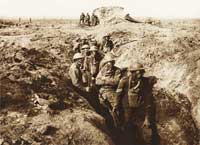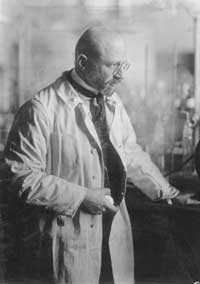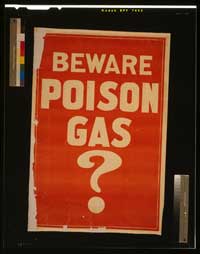Experiments in integrity – Fritz Haber and the ethics of chemistry Understand article
One hundred years after the start of the First World War, chemical weapons are still in the news. We consider some of the ethical questions behind the war’s chemical legacy.

small box respirators (SBR) at
Garter Point near Zonnebeke,
Ypres sector, 27 September
1917.
Image courtesy of Collection of
National Media Museum/
Wikimedia Commons
Our lives today have been greatly improved by chemistry, but no discovery has been universally positive. The negative consequences of chemistry, from pollution to thalidomide, have led to a public distrust of the science and a fear that the work of single-minded chemists in the laboratory will harm society. No more so than in the arena of war. One hundred years ago, at the beginning of the First World War, chemists worked to help their respective countries. The story of chemistry and chemists during that time can help us explore some of the complicated ethical history that underlies the field to this day.
Great power and great responsibility in the industrial age
There is a simple chemical reaction that, for many, symbolises the best and worst of late 19th and early 20th century chemistry: N2 + 3H2 ⇌ 2NH3. The apparently uncomplicated mixture of nitrogen and hydrogen was in fact a triumph of chemistry that earned Fritz Haber the Nobel Prize in Chemistry in 1918. Today more than 130 million tonnes of ammonia are produced each year using the so-called Haber-Bosch process, providing 99% of all nitrogen fertilisers.
Yet, for many, Haber is a controversial figure who also worked to create chemical weapons. Although his work on nitrogen fixing allows us to grow more food than ever before, Haber’s process for making ammonia is also thought to have prolonged the First World War by at least 18 months. The man who ‘made bread from air’ is a complicated figure.

Image courtesy of the German
Federal Archives/Wikimedia
Commons
During the 19th century, chemistry flourished and with it the capacity of chemists to do good or harm on a scale never before imagined. While the science rapidly improved people’s lives and health, it raised a spectre that threatened those same individuals. As life expectancy rose, and populations grew, more food was needed. However, the fertiliser of the time, nitrogen-rich guano from South America, had nearly run out. A new source of ammonia was needed. In collaboration with the German chemical firm BASF, and working with Robert Le Rossignol, a young British scientist, Haber achieved the first synthesis of ammonia using just hydrogen and nitrogen – gases from the air around us – in the early 1900s.
The German state and its success allowed Haber, the son of a Jewish city councillor in what is now Wroclaw, Poland, to pursue his intellectual thirst. Haber was fiercely patriotic; today, we might feel uncomfortable with such fervent nationalism, but at the time it was quite normal. Haber himself claimed that the sense of Germanhood was something to adjust to “like everything great and eternal” and at the age of 24 he converted to Christianity.
At the outbreak of war, British ships blockaded the import of guano from South America and so industrial production of ammonia was vital to feed the German population. The blockade was also a problem for the production of ammunitions, which need nitrates. As early as September 1914, a team of experts, including Haber, was appointed to find a solution to the problem; soon afterwards, chemical manufacturers were using Harber’s method to produce nitrates for explosives. But if Haber’s ethical standing could already be considered complicated, his next steps were even more controversial.
Father of chemical weaponry
It soon became clear that hopes of the war being ‘over by Christmas’ would not be realised and what had been planned as a lightning-fast war was digging in. Increasing the amount of firepower alone would not end the war quickly.

Congress/Wikimedia commons
For the patriotic Haber, it seems there was little doubt that all other considerations were secondary to the interests of his country. New technology could, he concluded, give Germany the decisive advantage to end the war quickly. If his efforts had succeeded, the war might have been over sooner with many more lives saved, but instead Haber’s discoveries have become one of the most controversial parts of modern warfare – chemical weapons.
Weaponised chemical irritants were already banned by the Hague Conventions of 1899 and 1907, but Haber was not working to produce just an irritant gas. Instead, he focused his efforts on a gas that would be a weapon in its own right. After extensive tests and analyses, Haber travelled to Ypres in April 1915. It was there that he supervised the first use of chlorine gas, now so inextricably linked to the trench warfare of the First World War.
Chlorine gas worked ‘well’, killing thousands, but it did not prove to be the military advantage Haber hoped it would be. Instead, chemical weapons just became another weapon during the war, and by defying the Hague Conventions, Germany’s actions provided the excuse that the Allies needed to roll out their own gases in response.
Shortly after Haber returned from Ypres, his wife committed suicide in protest at his work. Haber’s loyalty to the German cause seems to have remained unshaken and the next morning he left to oversee chlorine gas being used on the Eastern Front.
The ethical legacy of Fritz Haber

Image courtesy of Tijl
Vercaemer/Flickr
Subsequent generations, who have enjoyed the fruit of ammonia-based fertilisers, may have a more moderate view of Haber’s impact than his contemporaries, including his wife Clara. In 1918, just after the end of the First World War, Haber was awarded the Nobel Prize in Chemistry but his war work was widely known and there were protests against the award.However, the Nobel Committee recognised that as well as contributing to the creation of weapons, Haber’s work on the synthesis of ammonia meant that he was a man who had “conferred the greatest benefit to mankind”.
Haber’s work illustrates the idea of individual responsibility. Although some of his work caused suffering and was designed to do so, other parts benefitted humanity. Doing good to others is viewed positively by all ethical criteria, but it could be argued that such good is cancelled out by unethical behaviour and harm.
Clara Immerwahr

(1870–1915)
Image courtesy of Wikimedia
Commons
Before marrying Fritz Haber, Clara Immerwahr was an accomplished chemist in her own right. In fact, she was perhaps the first woman to earn a PhD in chemistry in Germany. Societal expectations at the time were that the highest a woman could hope to rise was lab assistant. After her marriage to Fritz, Clara felt increasingly stifled and found that her research career became incompatible with the role of wife and mother that she was expected to fulfill. However she worked with her husband behind the scenes and continued to give lectures to women.
The marriage was already in trouble by the time Fritz Haber began his war work. A pacifist, Immerwahr pleaded with him to stop his work on chemical weapons, and publicly denounced it as a “perversion of the ideals of science”. He responded by denouncing her as a traitor.
This year, Clara Immerwahr has been the subject of a successful biopic on German television.
Events during the Second World War, many of which were highly dependent on the work of scientists, such as the use of atomic weapons and the events of the Holocaust, were more enormous and more terrible than ever before. Society was forced to re-evaluate whether individual conscience could be sufficient to regulate the work of scientists. In 1947 the Nuremburg Code was drafted to set out the principles by which scientific research on humans should be conducted. All research, whether or not it involves living subjects, is now required to conform to the principles of research ethics, which consider both the reliability of the findings and the ethical impact of the research methods. Research ethics specify the standards of honesty expected of each researcher and make it obligatory to open work up for scrutiny by others. However, we can never truly be sure of the impact of our work, and of what others might use it for.
The ethical history of the Nobel Prizes
Another chemist forced to re-evaluate the ethicality of his work was Alfred Nobel, whose name is now most commonly associated with the Nobel Prizes that are funded from his legacy. Nobel made his fortune manufacturing dynamite, originally for mining. However, the use of dynamite in warfare was criticised by Swedish society, as Nobel was distressed to discover when his obituary was mistakenly published while he was still alive. Perhaps because of these criticisms, when Nobel did die, his will founded the Nobel prizes.
Resources
- The Haber process helps to feed the world but has also taken its toll on the environment. To find out more, watch Daniel Dulek’s lesson on ‘The Haber process’ at TED-Ed.
- A recent short film about Fritz Haber, called ‘Haber’, is now available on DVD. The filmmakers have also made free teacher resources including scientific overviews of Haber’s discoveries and the surrounding ethical debate.
- The First World War website, which describes itself as a multimedia history of World War I, also has an interesting page on the development and use of chemical weapons during the conflict.
- The Nobel Prize website contains information about all Nobel Prize winners and Alfred Nobel himself, including an article exploring Alfred Nobel’s thoughts on war and peace.
Review
This article shows an interdisciplinary approach to the study of the benefits and risks related to scientific research. The article might provide valuable background information for oral presentations or projects.
Angela Köhler, Romain-Rolland-Gymnasium, Germany





